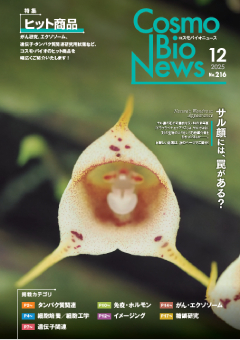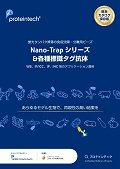PROTEOSTAT® アグリソーム検出キットは、アグリソームやアグリソーム様凝集体をフローサイトメトリーやイメージングで解析します。
使用目的
PROTEOSTAT® アグリソーム検出キットには、488 nm で励起する赤色蛍光分子ローター色素が含まれており、固定細胞や透過処理済み細胞のアグリソームやアグリソーム様封入体内に存在する、変性カーゴタンパク質を特異的に検出します。検出試薬はアグリソーム形成中に生産された小胞内の凝集タンパク質と結合することで強く蛍光を発します。そしてオートファジー、プロテアソーム経路の様々な条件下でバリデートされています。
キットには、プロテアソーム阻害剤である MG-132 がポジティブコントロールとして、また核の対比染色試薬も入っています。
- 文献で使用されているサンプル一覧はこちら

特長
- セルベースアッセイによる薬剤応答アッセイ:実際の生細胞条件下での神経変性疾患に関与するインヒビターを同定可能
- 信頼性が高く簡便:非生理的なタンパク質のミューテーションや遺伝子組換え細胞株不要
- 固定化細胞アッセイ:凝集したタンパク質とアグリソーム形成に関わる様々なタンパク質間の相互作用を解析可能
- フローサイトメトリーでアグリソーム蓄積を簡単定量
構成内容
- PROTEOSTAT® アグリソーム検出試薬
- Hoechst 33342 Nuclear stain
- プロテアソームインヒビター(MG-132)
- アッセイバッファー(×10)
テックノート
- Detection of bacterial aggregation by flow cytometry

- A Red-emitting Fluorescent Probe for Rapid Detection of Protein and Peptide Aggregates in Post-mortem Human Brain Tissue Sections from Patients Diagnosed with Alzheimer’s and Parkinson’s Disease

-
Monitoring the Accumulation and Clearance of Exogenously Introduced Beta-amyloid in a Cell-Based Model of Alzheimer’s Disease by Fluorescence Microscopy and Fluorescence Microplate Assay

-
Towards Understanding the Molecular Basis of Parkinson’s Disease: Cell-based Model of Mitophagy and Aggresome Accumulation

- Cell-Based Screening of Focused Bioactive Compound Libraries: Assessing Small Molecule Modulators of the Canonical Wnt Signaling and Autophagy-Lysosome Pathways

使用例
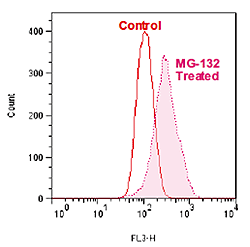
| Treatment | Mean(FL3)Signal |
|---|---|
| Control | 113 |
| Treatment(5μM MG-132) | 335 |
図1 フローサイトメトリーによるアグリソーム解析
Jurkat細胞を5μM MG-132で一晩37℃誘導したものとmockを用意。処理後、細胞を固定し PROTEOSTAT® 検出試薬とインキュベートした。フローサイトメトリーで検出したヒストグラムを示す。
MG-132処理細胞では、赤色蛍光シグナルが約3倍増加した。

図2 PROTEOSTAT® 検出試薬で検出されるアグリソームはFITC標識ユビキチン抗体と共通の局在を示す。
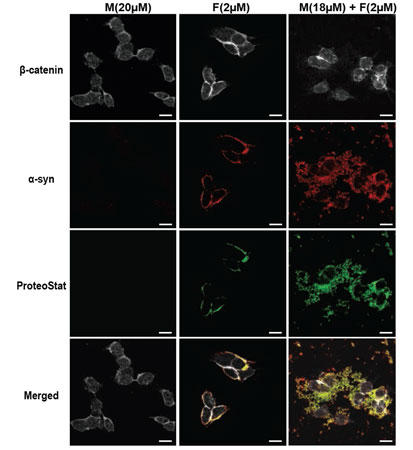
図3 α-syn 混合物は M17 神経芽細胞系に内在する細胞原形質膜で凝集体を形成する。
α-syn モノマーで処理した M17 細胞(M)、ソニケートした α-syn PFFs で処理した M17 細胞(F)、α-syn 混合物で処理した M17 細胞(M+F)。4日後、M17 細胞を固定前に3回洗浄し、それから PROTEOSTAT® アグリソーム検出試薬(緑)で染色、α-syn(赤)および β-catenin(グレイ)に対する抗体を使い、免疫染色を行った。スケールバー = 20 µm。
(“Fibril growth and seeding capacity play key roles in α-synuclein-mediated apoptotic cell death. A-L Mahul-Mellier, et al.; Cell Death & Differentiation (2015).” (doi:10.1038/cdd.2015.79))
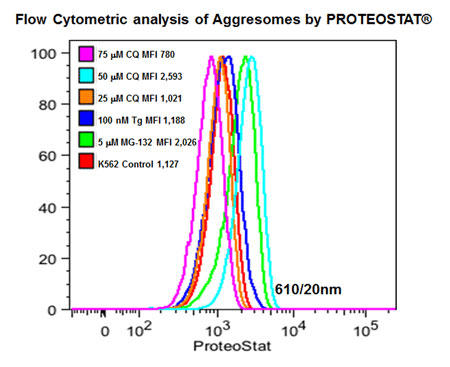
図4 オートファジーに関連するERストレスによって誘導されたタンパク質アグリソームのフローサイトメトリー解析
K562 細胞を CQ(25, 50, 75 µM)、thapsigargin(Tg :100 nM)、MG-132(5 µM)で24時間処理、もしくは未処理を用意した。その後、固定・透過処理を行い、PROTEOSTAT® アグリソーム検出試薬(1:10,000 希釈)を室温で30分反応させた。その後、細胞(30,000)を BD LSR II、610/20nm(青)チャンネルで解析した。
(Courtesy of the Flow Cytometry Core Facility, Blizard Institute, Queen Mary University of London, London, UK.)
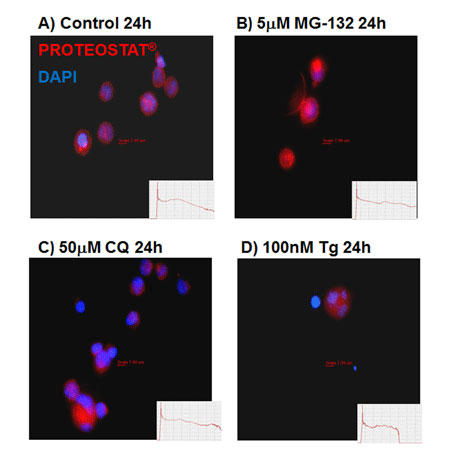
図5 オートファジーに関連するERストレスによって誘導されたアグリソームやアグリソーム様封入体(ALSI)の落射蛍光顕微鏡画像
A) 未処理の K562 細胞、B) MG-132(5 µM)、C) CQ(50 µM)、D) thapsigargin(Tg: 100 nM)で24時間処理、その後、固定・透過処理を行い、PROTEOSTAT® アグリソーム検出試薬(1:10,000 希釈)を室温で30分反応させた。PROTEOSTAT® アグリソーム染色には、アグリソーム、ALIS 細胞を赤色で、DAPI 染色を青色で示す。
(Courtesy of the Flow Cytometry Core Facility, Blizard Institute, Queen Mary University of London, London, UK.)
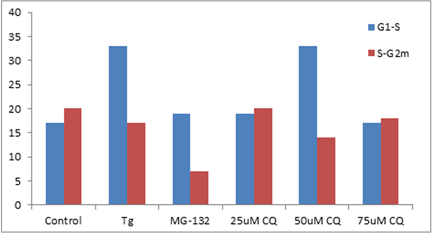
図6. ERストレスおよび不完全オートファジー誘導試薬を処理したK562細胞のAPF解析
K562細胞を、ERストレスおよび不完全オートファジーを誘導する試薬Thapsigargin(Tg、0.1µM)、25、50および75µMのChloroquine(CQ)をそれぞれ24時間処理した。プロテアソーム阻害剤 MG-132 (5 µM) をポジティブコントロールとして24 時間使用した。ペレット化した細胞を固定し、透過処理した。次に細胞を、メーカーの指示に従って300µl PROTEOSTAT® Aggresome Detection reagent (Enzo Life Sciences)および1µg/ml DAPI (細胞周期決定用)を用いて室温で30分間標識した。 G1期を上回るS期のアグレソーム傾向因子(APF)およびS期を上回るG2m期のアグリソーム傾向因子(APF)の相対的増加を各治療について決定し、対照値と比較した。 ER ストレス誘導物質である Tg と 50 µM CQ は両方とも、対照と比較して G1期よりも S期でアグレソームをより上方制御することが示された。一方、プロテアソーム阻害剤である MG-132 および 50 µM CQ は、コントロールや S期よりも G2m 期でアグリソームを下方制御することが示された。(Courtesy of the Flow Cytometry Core Facility, Blizard Institute, Queen Mary University of London, London, UK.)
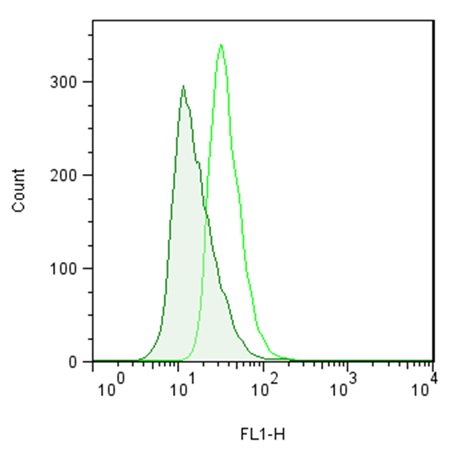
図7. フローサイトメトリーによるアグリソーム解析
Jurkat 細胞を 0.2% DMSO で模擬誘導または、5 µM MG-132 で 37℃ で一晩誘導した。処理後、細胞を固定し、Fluorescein-p62 Ab (希釈率 1:500) でインキュベートし、洗浄後、フローサイトメトリーで分析した。(FL1 チャネル:488 nm レーザー)
MG-132 処理細胞では、Fluorescein-p62 Ab シグナルが約 2.5 倍増加した。
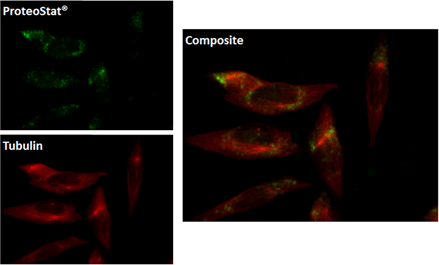
図8. HeLa 細胞におけるアグリソームとTubulinの解析
細胞を5µM MG-132 で 12 時間処理し、ProteoStat® アグリソーム色素で検出した(左上、緑色で表示) 。
また、Alexa Fluor® 647-Tubulin 抗体で染色した(左下、赤色で表示)。
合成画像(右)において、Tubulinとの共局在を示した。(蛍光顕微鏡使用)
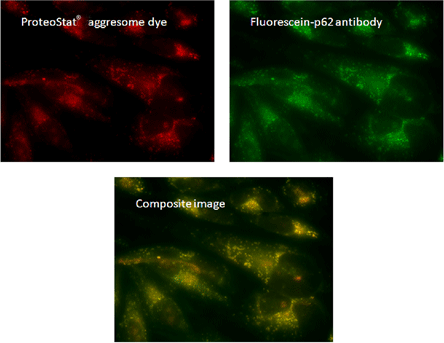
図9. HeLa 細胞におけるアグリソームとp62の解析
細胞を5µM MG-132 で 12 時間処理し、ProteoStat® アグリソーム色素で検出した(左上、赤色で表示) 。
また、フルオレセイン p62 抗体で染色した(右上、緑色で表示)。
合成画像(中央下)において、p62 との共局在を示した。(蛍光顕微鏡使用)
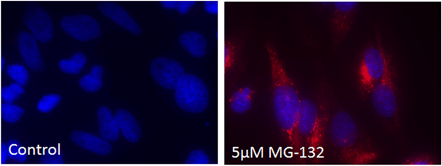
図10. HeLa 細胞におけるアグリソーム解析およびHoechst 33342による対比染色
細胞を5µM MG-132 で 12 時間処理し、ProteoStat® アグリソーム色素で検出した(赤色) 。
また、Hoechst 33342 で対比染色した(青色)。左のコントロール パネルはMG-132未処理。(蛍光顕微鏡使用)
PROTEOSTAT® アグリソーム検出キット
| 品名 | メーカー | 品番 | 包装 | 希望販売価格 |
|---|---|---|---|---|
PROTEOSTAT(R) Aggresome detection kit |
ENZ | ENZ-51035-K100 | 1 KIT [100 flow cytometry assays or 200 microscopy assays] |
¥91,000 |
PROTEOSTAT(R) Aggresome detection kit |
ENZ | ENZ-51035-0025 | 1 KIT [25 flow cytometry assays or 50 microscopy assays] |
¥32,000 |
製品使用文献
- Immunofluorescence and Aggresome Staining of Nothobranchius furzeri Cryosections: S. Bagnoli, et al.; Cold Spring Harb. Protoc. 2023, 693 (2023), Abstract;
- Insulin regulates human pancreatic endocrine cell differentiation in vitro: P. Cota, et al.; Mol. Metab. 79, 101853 (2023), Abstract;
- Oxidative-Stress-Mediated ER Stress Is Involved in Regulating Manoalide-Induced Antiproliferation in Oral Cancer Cells: S.Y. Peng, et al.; Int. J. Mol. Sci. 24, 3987 (2023), Abstract;
- Transcriptomic characterization of Lonrf1 at the single-cell level under pathophysiological conditions: D. Li, et al.; J. Biochem. 173, 459 (2023), Abstract;
- A meiotic switch in lysosome activity supports spermatocyte development in young flies but collapses with age: T.J. Butsch, et. al.; iScience 25, 104382 (2022), Abstract;
- A novel HIF-2α targeted inhibitor suppresses hypoxia-induced breast cancer stemness via SOD2-mtROS-PDI/GPR78-UPRER axis: Y. Yan, et al.; Cell Death Differ. 1038, s41418 (2022), Abstract;
- Apoptotic mechanism in human brain microvascular endothelial cells triggered by 4′-iodo-α-pyrrolidinononanophenone: Contribution of decrease in antioxidant properties: Y. Sakai, et al.; Toxicol. Lett. 351, 127 (2022), Abstract;
- Calcium dysregulation potentiates wild-type myocilin misfolding: implications for glaucoma pathogenesis: E.G. Saccuzzo, et al.; J. Biol. Inorg. Chem. 27, 553 (2022), Abstract;
- Copper oxide nanoparticles trigger macrophage cell death with misfolding of Cu/Zn superoxide dismutase 1 (SOD1): G. Gupta, et al.; Part. Fibre Toxicol. 19, 33 (2022), Abstract;
- De novo sphingolipid biosynthesis necessitates detoxification in cancer cells: M.E. Spears, et al.; Cell Rep. 40, 111415 (2022), Abstract;
- Engineered Riboswitch Nanocarriers as a Possible Disease-Modifying Treatment for Metabolic Disorders: S. Zilberzwige-Tal , et al.; ACS Nano 16, 11733 (2022), Application(s): Quantification of amyloid protein in yeast after treatment with riboswitch nanocarriers, Abstract;
- Error-prone protein synthesis recapitulates early symptoms of Alzheimer disease in aging mice: M. Brilkova, et al.; Cell Rep. 40, 111433 (2022), Abstract;
- Human Cathelicidin Peptide LL-37 Induces Cell Death in Autophagy Dysfunctional Endothelial Cells: K. Suzuki, et al.; J. Immunol. 208, 2163 (2022), Abstract;
- Identification of Novel Oxindole Compounds That Suppress ER Stress-Induced Cell Death as Chemical Chaperones: Y. Hasegawa, et al.; ACS Chem. Neurosci. 13, 1055 (2022), Abstract;
- IGF-1 as a Potential Therapy for Spinocerebellar Ataxia Type 3: Y.-S. Lin, et al.; Biomedicines 10, 505 (2022), Abstract;
- Induction of Oxidative Stress in SH-SY5Y Cells by Overexpression of hTau40 and Its Mitigation by Redox-Active Nanoparticles: N. Pie kowska, et al.; Int. J. Mol. Sci. 24, 359 (2022), Abstract;
- New lessons on TDP-43 from old N. furzeri killifish: A. Louka, et al.; Aging Cell 21, e13517 (2022), Abstract;
- Premature aging in mice with error-prone protein synthesis: D. Shcherbakov, et al.; Sci. Adv. 8, eabl9051 (2022), Abstract;
- Proteasome inhibition triggers the formation of TRAIL receptor 2 platforms for caspase-8 activation that accumulate in the cytosol: C.T. Hellwig, et al.; Cell Death Differ. 29, 147 (2022), Abstract;
- Quantification of noradrenergic-, dopaminergic-, and tectal neurons during aging in the short-lived killifish Nothobranchius furzeri: S. Bagnoli, et al.; Aging Cell 21, e13689 (2022), Abstract;
- The Nrf1 transcription factor is induced by patulin and protects against patulin cytotoxicity: J.J.W. Han, et al.; Toxicology 471, 153173 (2022), Abstract;
- αA and αB peptides from human cataractous lenses show antichaperone activity and enhance aggregation of lens proteins: O. Srivastava, et al.; Mol. Vis. 28, 147 (2022), Abstract;
- Artepillin C, a major component of Brazilian green propolis, inhibits endoplasmic reticulum stress and protein aggregation: Y. Hirata, et al.; Eur. J. Pharmacol. 912, 174572 (2021), Abstract;
- ATP-citrate lyase promotes axonal transport across species: A. Even, et al.; Nat. Commun. 12, 5878 (2021), Abstract;
- Cell-Instructive Surface Gradients of Photoresponsive Amyloid-like Fibrils: A.M. Bender, et al.; ACS Biomater. Sci. Eng. 7, 4798 (2021), Abstract;
- Dual Targeting of Endoplasmic Reticulum by Redox-Deubiquitination Regulation for Cancer Therapy: B. Cai, etr al.; Int. J. Nanomedicine 16, 5193 (2021), Abstract;
- Inhibition of cardiac PERK signaling promotes peripartum cardiac dysfunction: T. Shimizu, et al.; Sci. Rep. 11, 18687 (2021), Abstract;
- New evidences of ubiquitin-proteasome system activity in human sperm: J.V. Silva, et al.; Biochim. Biophys. Acta Mol. Cell. Res. 1868, 118932 (2021), Application(s): Microscopy; detection of aggresome-like inclusion bodies in human sperm, Abstract;
- Novel blood test for early biomarkers of preeclampsia and Alzheimer’s disease: S. Cheng, et al.; Sci. Rep. 11, 15934 (2021), Abstract;
- Proteotoxic stress is a driver of the loser status and of cell competition: M. E. Baumgartner, et al.; Nat. Cell Biol. 23, 136 (2021), Application(s): Fluorescence imaging of fly larvae, Abstract; Full Text
- Sodium sulfite causes gastric mucosal cell death by inducing oxidative stress: O. Moeri, et al.; Free Radic. Res. 55, 731 (2021), Abstract;
- The intrinsic chaperone network of Arabidopsis stem cells confers protection against proteotoxic stress: E. Llamas, et al.; Aging Cell 20, e13446 (2021), Application(s): Quantitative fluorescence imaging of Arabidopsis roots, Abstract; Full Text
- The mechanism of cell death induced by silver nanoparticles is distinct from silver cations: M.M. Rhode, et al.; Part. Fibre Toxicol. 18, 37 (2021), Abstract;
- 4-Phenylbutyrate ameliorates apoptotic neural cell death in Down syndrome by reducing protein aggregates: K. Hirata, et al.; Sci. Rep. 10, 14047 (2020), Abstract; Full Text
- Cytokinin-induced protein synthesis suppresses growth and osmotic stress tolerance: S.S. Karunadasa, et al.; New Phytol. 227, 50 (2020), Application(s): Confocal microscopy; A. thaliana seedlings, Abstract;
- Differentiation Drives Widespread Rewiring of the Neural Stem Cell Chaperone Network: W.I.M. Vonk, et al.; Mol. Cell 78, 328 (2020), Abstract;
- DMSO impairs the transcriptional program for maternal-to-embryonic transition by altering histone acetylation: M.H. Kang, et al.; Biomaterials 230, 119604 (2020), Application(s): Confocal microscopy using mouse embryos, Abstract;
- Downregulated miR-18b-5p triggers apoptosis by inhibition of calcium signaling and neuronal cell differentiation in transgenic SOD1 (G93A) mice and SOD1 (G17S and G86S) ALS patients: K.Y. Kim, et al.; Transl. Neurodegener. 9, 23 (2020), Abstract; Full Text
- Galectin-3 promotes Aβ oligomerization and Aβ toxicity in a mouse model of Alzheimer’s disease: C.C. Tao, et al.; Cell Death Differ. 27, 192 (2020), Application(s): Visualisation of amyloid plaques on mouse brain sections, Abstract; Full Text
- hnRNPDL phase separation is regulated by alternative splicing and disease-causing mutations accelerate its aggregation: C. Batlle, et al.; Cell Rep. 30, 1117 (2020), Application(s): Fluorescence microscopy using aggregated proteins in solution, Abstract;
- Intravaginal poly-(D, L-lactic-co-glycolic acid)-(polyethylene glycol) drug-delivery nanoparticles induce pro-inflammatory responses with Candida albicans infection in a mouse model: T.T. Lina, et al.; PLoS One 15, e0240789 (2020), Abstract; Full Text
- Keap1 governs ageing-induced protein aggregation in endothelial cells: A. Kopacz,et al.; Redox Biol. 34, 101572 (2020), Abstract;
- Mitochondrial dysfunction generates aggregates that resist lysosomal degradation in human breast cancer cells: T. G. Biel, et al.; Cell Death Dis. 11, 460 (2020), Application(s): Fluorescence Imaging and Flow Cytometry of human breast cancer cells MDA-MB-231, Abstract; Full Text
- Relationship between the Length of Sperm Tail Mitochondrial Sheath and Fertility Traits in Boars Used for Artificial Insemination: K. Kerns, et al. ; Antioxidants (Basel) 9, E1033 (2020), Application(s): Microscope imaging-morphometry and image-based flow cytometry on sperm samples, Abstract;
- Targeting p53 and histone methyltransferases restores exhausted CD8+ T cells in HCV infection: V. Barili, et al.; Nat. Commun. 11, 604 (2020), Application(s): Flow cytometry using human PBMCs, Abstract; Full Text
- West Nile virus capsid protein inhibits autophagy by AMP-activated protein kinase degradation in neurological disease development: S. Kobayashi, et al.; PLoS Pathog. 16, e1008238 (2020), Application(s): Confocal and fluorescence microscopy using SK-N-SH cells, Abstract;
- A Flow Cytometric Study of ER Stress and Autophagy: A. Popat, et al.; Cytometry A 95, 672 (2019), Abstract; Full Text
- A new histone deacetylase inhibitor enhances radiation sensitivity through the induction of misfolded protein aggregation and autophagy in triple-negative breast: H.W. Chiu, et al.; Cancers (Basel) 11, 1703 (2019), Application(s): Fluorescence microscopy using 4T1, MDA-MB-231, and MCF-10A cells, Abstract; Full Text
- An SOD1 deficiency aggravates proteasome inhibitor bortezomib-induced testicular damage in mice: T. Homma & J. Fujii; Biochim. Biophys. Acta Gen. Subj. 1863, 1108 (2019), Application(s): Mouse cryosectioned tissue, Abstract;
- Autophagy augmentation alleviates cigarette smoke-induced CFTR-dysfunction, ceramide-accumulation and COPD-emphysema pathogenesis: M. Bodas, et al.; Free Radic. Biol. Med. 131, 81 (2019), Application(s): Co-staining and fluorescence microscopy using human and murine lung tissue sections, Abstract;
- Bassoon proteinopathy drives neurodegeneration in multiple sclerosis: B. Schattling, et al.; Nat. Neurosci. 22, 887 (2019), Application(s): Confocal microscopy using mouse neurons, Abstract;
- Cardiac-specific Mst1 deficiency inhibits ROS-mediated JNK signalling to alleviate Ang II-induced cardiomyocyte apoptosis: Z. Cheng, et al.; J. Cell. Mol. Med. 23, 543 (2019), Abstract; Full Text
- CBP/p300 Bromodomains Regulate Amyloid-like Protein Aggregation upon Aberrant LysineAcetylation: H. Olzscha, et al.; Cell Chem. Biol. 24, 9 (2019), Abstract;
- Cell-based HTS identifies a chemical chaperone for preventing ER protein aggregation and proteotoxicity: K. Kitakaze, et al.; eLife 8, e43302 (2019), Application(s): Fluorescence microscopy and high-content analysis system using HEK293 cells, Abstract; Full Text
- Designer amyloid cell-penetrating peptides for potential use as gene transfer vehicles: C. Kokotidou, et al.; Biomolecules 10, 7 (2019), Application(s): Confocal microscopy using HEK293 cells, Abstract;
- Disturbances in H+ dynamics during environmental carcinogenesis: D. Lagadic-Gossmann, et al.; Biochimie 163, 171 (2019), Application(s): Fluorescence microscopy using F258 cells, Abstract;
- Dual role of ribosome-binding domain of NAC as a potent suppressor of protein aggregation and aging-related proteinopathies: K. Shen, et al.; Mol. Cell 74, 729 (2019), Application(s): Fluorescence microscopy using ST HDH Q7/7 and ST HDH Q7/111 cells, Abstract; Full Text
- Elimination of protein aggregates prevents premature senescence in human trisomy 21 fibroblasts: N. Nawa, et al.; PLoS One 14, e0219592 (2019), Abstract; Full Text
- Fibril formation and therapeutic targeting of amyloid-like structures in a yeast model of adenine accumulation: D. Laor, et al.; Neurochem. Res. 10, 62 (2019), Application(s): Flow cytometry and confocal imaging of yeast cells, Abstract; Full Text
- Functional transcriptome analysis in ARSACS KO cell model reveals a role of sacsin in autophagy: F. Morani, et al.; Sci. Rep. 9, 11878 (2019), Application(s): Co-staining and fluorescence microscopy using SH-SY5Y cells, Abstract; Full Text
- GRASP55 and UPR control interleukin-1β aggregation and secretion: M. Chiritoiu, et al.; Dev. Cell 49, 145 (2019), Abstract;
- Impaired mitochondrial calcium efflux contributes to disease progression in models of Alzheimer's disease: P. Jadiya, et al.; Nat. Commun. 10, 3885 (2019), Application(s): Confocal microscopy using mouse neuronal cells, Abstract; Full Text
- In vivo phenotyping of familial Parkinson's Disease with human induced pluripotent stem cells: a proof-of-concept study: O. Zygogianni, et al.; Neurochem. Res. 44, 1475 (2019), Application(s): Co-staining and fluorescence microscopy, Abstract;
- Knockdown of TM9SF4 boosts ER stress to trigger cell death of chemoresistant breast cancer cells: Y. Zhu, et al.; Oncogene 38, 5778 (2019), Application(s): Flow cytometry using MCF-7 cells, Abstract;
- Metformin augments panobinostat's anti-bladder cancer activity by activating AMP-activated protein kinase: K. Okubo, et al.; Transl. Oncol. 12, 669 (2019), Application(s): Fluorescence microscopy using UMUC3 and J82 human bladder cancer cells, Abstract; Full Text
- Monitoring the aggregation of GPCRs by fluorescence microscopy: S. Genier, et al.; Methods Mol. Biol. 1947, 289 (2019), Application(s): Confocal microscopy, Abstract;
- mTORC1 signaling is palmitoylation-dependent in hippocampal neurons and non-neuronal cells and involves dynamic palmitoylation of LAMTOR1 and mTOR: S.S. Sanders, et al.; Front. Cell. Neurosci. 13, 115 (2019), Application(s): Fluorescence microscopy using rat neurons, Abstract; Full Text
- Rescue of tight junctional localization of a claudin-16 mutant D97S by antimalarial medicine primaquine in Madin-Darby canine kidney cells: K. Marukana, et al.; Sci. Rep. 9, 9647 (2019), Application(s): Fluorescence microscopy using MDCK cells, Abstract; Full Text
- Retinoic acid worsens ATG10-dependent autophagy impairment in TBK1-mutant hiPSC-derived motoneurons through SQSTM1/p62 accumulation: A. Catanese, et al.; Autophagy. 15, 1719 (2019), Application(s): Fluorescence microscopy using tissue sections, Abstract;
- Screening Protein Aggregation in Cells Using Fluorescent Labels Coupled to Flow Cytometry: S. Ventura, et al.; Methods Mol. Biol. 1873, 195 (2019), Application(s): Detailed Protocol for PROTEOSTAT analysis of protein aggregation in yeast and bacteria, Abstract;
- The center of olfactory bulb‐seeded α‐synucleinopathy is the limbic system and the ensuing pathology is higher in male than in female mice: D.M. Mason, et al.; Brain Pathol. 29, 741 (2019), Application(s): Co-staining and fluorescence microscopy, Abstract;
- The chaperonin TRiC/CCT associates with Prefoldin through a conserved electrostatic interface essential for cellular proteostasis: D.Gestaut, et al.; Cell 177, 751 (2019), Application(s): Fluorescence microscopy of yeast cells, Abstract; Full Text
- TRPML1 promotes protein homeostasis in melanoma cells by negatively regulating MAPK and mTORC1 signaling: S.Y. Kasitinon, et al.; Cell Rep. 28, 2293 (2019), Application(s): Fluorescence microscopy using melanoma cells, Abstract; Full Text
- Acute exposure to organic and inorganic sources of copper: Differential response in intestinal cell lines: J. Keenan, et al.; Food Sci. Nutr. 6, 2499 (2018), Application(s): Microplate assay using Caco-2 and HT-29 cells, Abstract; Full Text
- ATF6 safeguards organelle homeostasis and cellular aging in human mesenchymal stem cells: S. Wang, et al.; Cell Discov. 4, 2 (2018), Application(s): Flow cytometry using human mesenchymal stem cells, Abstract; Full Text
- Cigarette smoke induced autophagy-impairment accelerates lung aging, COPD-emphysema exacerbations and pathogenesis: N. Vij, et al.; Am. J. Physiol. Cell. Physiol. 314, C73 (2018), Abstract;
- Culling less fit neurons protects against amyloid-β-induced brain damage and cognitive and motor decline: D.S. Coelho, et al.; Cell Rep. 25, 3661 (2018), Application(s): Confocal microscopy using fly brain tissue section, Abstract; Full Text
- Ethanol induced disordering of pancreatic acinar cell endoplasmic reticulum: an ER stress/defective unfolded protein response model: R.T. Waldron, et al.; Cell. Mol. Gastroenterol. Hepatol. 5, 479 (2018), Application(s): Confocal microscopy using AR42J cells, Abstract; Full Text
- iPSCs from a hibernator provide a platform for studying cold adaptation and its potential medical applications: J. Ou, et al.; Cell 173, 851 (2018), Application(s): Fluorescence microscopy using squirrel neurons, Abstract; Full Text
- Novel polyubiquitin imaging system, PolyUb-FC, reveals that K33-linked polyubiquitin is recruited by SQSTM1/p62: Y. Nibe, et al.; Autophagy 14, 347 (2018), Application(s): Fluorescence microscopy using HEK293T cells, Abstract; Full Text
- Spermine increases acetylation of tubulins and facilitates autophagic degradation of prion aggregates: K. Phadwal, et al.; Sci. Rep. 8, 10004 (2018), Application(s): Confocal microscopy with CAD and SMB cells, Abstract; Full Text
- The ubiquitin ligase UBR5 suppresses proteostasis collapse in pluripotent stem cells from Huntington's disease patients: S. Koyuncu, et al.; Nat. Commun. 9, 2886 (2018), Application(s): Fluorescence microscopy using pluripotent stem cells, Abstract; Full Text
- A leptospiral AAA+ chaperone-Ntn peptidase complex, HslUV, contributes to the intracellular survival of Leptospira interrogans in hosts and the transmission of leptospirosis: S.L. Dong, et al.; Emerg. Microbes Infect. 6, e105 (2017), Application(s): Protein aggresome detection in intracellular leptospires, Abstract; Full Text
- Augmentation of S-Nitrosoglutathione Controls Cigarette Smoke-Induced Inflammatory-Oxidative Stress and Chronic Obstructive Pulmonary Disease-Emphysema Pathogenesis by Restoring Cystic Fibrosis Transmembrane Conductance Regulator Function: M. Bodas, et al.; Antioxid. Redox Signal. 27, 433 (2017), Application(s): Human and murine lung tissue, Abstract; Full Text
- Characterization of cadmium chloride-induced BiP accumulation in Xenopus laevis A6 kidney epithelial cells: C.S. Shirriff, et al.; Comp. Biochem. Physiol. C. Toxicol. Pharmacol. 191, 117 (2017), Application(s): Immunocytochemical analysis and laser scanning confocal microscopy, Abstract;
- Endoplasmic Reticulum Stress Response in Arabidopsis Roots: Y. Cho, et al.; Front. Plant Sci. 8, 144 (2017), Application(s): Fluorescence Imaging of Arabidopsis roots, Abstract; Full Text
- FKBP8 protects the heart from hemodynamic stress by preventing the accumulation of misfolded proteins and endoplasmic reticulum-associated apoptosis in mice: T. Misaka, et al.; J. Mol. Cell. Cardiol. 114, 93 (2017), Abstract;
- Histone deacetylase 6 (HDAC6) is an essential factor for oocyte maturation and asymmetric division in mice: D. Zhou, et al.; Sci. Rep. 7, 8131 (2017), Application(s): Mouse Oocyte Samples, Abstract; Full Text
- OSM mitigates post-infarction cardiac remodeling and dysfunction by up-regulating autophagy through Mst1 suppression: J. Hu, et al.; Biochim. Biophys. Acta 1863, 1951 (2017), Abstract;
- p53 amyloid formation leading to its loss of function: implications in cancer pathogenesis: S. Ghosh, et al.; Cell Death Differ. 24, 1784 (2017), Application(s): p53 aggregate formation in SY5Y cells, Abstract; Full Text
- Polyethylene glycol-functionalized poly (Lactic Acid-co-Glycolic Acid) and graphene oxide nanoparticles induce pro-inflammatory and apoptotic responses in Candida albicans-infected vaginal epithelial cells: R.D. Wagner, et al.; PLoS One 12, e0175250 (2017), Abstract; Full Text
- Subcellular localization of the five members of the human steroid 5α-reductase family: A. Scaglione, et al.; Biochim. Open 4, 99 (2017), Application(s): Fluorescence Microscopy of HeLa cells, Abstract; Full Text
- Targeting mitochondrial dysfunction can restore antiviral activity of exhausted HBV-specific CD8 T cells in chronic hepatitis B: P. Fisicaro, et al.; Nat. Med. 23, 327 (2017), Abstract;
- A fast and specific method to screen for intracellular amyloid inhibitors using bacterial model systems: S. Navarro, et al.; Eur. J. Med. Chem. 121, 785 (2016), Application(s): Confocal microscopy, Abstract;
- Ad-HGF improves the cardiac remodeling of rat following myocardial infarction by upregulating autophagy and necroptosis and inhibiting apoptosis: J. Liu, et al.; Am. J. Transl. Res. 8, 4605 (2016), Abstract; Full Text
- Airway exposure to e-cigarette vapors impairs autophagy and induces aggresome formation: P.C. Shivalingappa, et al.; Antioxid. Redox Signal. 24, 186 (2016), Abstract;
- Bile acids protect expanding hematopoietic stem cells from unfolded protein stress in fetal liver: Y. Sigurdsson, et al.; Cell Stem Cell 18, 522 (2016), Abstract;
- Casitas B-cell lymphoma (Cbl) proteins protect mammary epithelial cells from proteotoxicity of active c-Src accumulation: C. Mukhopadhyay, et al.; PNAS 113, E8228 (2016), Abstract; Full Text
- Comprehensive proteomic study of the antiproliferative activity of a polyphenol-enriched rosemary extract on colon cancer cells using nanoliquid chromatography-orbitrap MS/MS: A. Valdes, et al.; J. Proteome Res. 15, 1971 (2016), Abstract;
- Distinct roles for intracellular and extracellular lipids in hepatitis C virus infection: S. Narayanan, et al.; PLoS One 11, e0156996 (2016), Application(s): Multiphoton microscopy using human hepatocellular carcinoma HuH7.5.1 cells, Abstract; Full Text
- Lin28a protects against postinfarction myocardial remodeling and dysfunction through Sirt1 activation and autophagy enhancement: Y. Hao, et al.; Biochem. Biophys. Res. Commun. 479, 833 (2016), Application(s): Aggresome and p62 detection, Abstract;
- LRRK2 interferes with aggresome formation for autophagic clearance: Y. Bang, et al.; Mol. Cell. Neurosci. 75, 71 (2016), Application(s): Protein aggregate analysis, Abstract;
- Luteolin alleviates post-infarction cardiac dysfunction by up-regulating autophagy through Mst1 inhibition: J. Hu, et al.; J. Cell. Mol. Med. 20, 147 (2016), Application(s): Confocal microscopy using mouse cardiomyocytes, Abstract; Full Text
- Monitoring of dipeptidyl peptidase-IV (DPP-IV) activity in patients with mucopolysaccharidoses types I and II on enzyme replacement therapy - Results of a pilot study: K. Hetmanczyk, et al.; Clin. Biochem. 49, 458 (2016), Application(s): Plasma DPP-IV enzyme assay, Abstract;
- A fast and specific method to screen for intracellular amyloid inhibitors using bacterial model systems: S. Navarro, et al.; Eur. J. Med. Chem. (2015), Application(s): Confocal microscopy, Abstract;
- Amyloidogenic lysozymes accumulate in the endoplasmic reticulum accompanied by the augmentation of ER stress signals: Y. Kamada, et al.; Biochim. Biophys. Acta 1850, 1107 (2015), Application(s): Microscopy, Abstract;
- Conophylline protects cells in cellular models of neurodegenerative diseases by inducing mammalian target of rapamycin (mTOR)-independent autophagy: Y. Sasazawa, et al.; J. Biol. Chem. 290, 6168 (2015), Abstract;
- Decreased proteasomal function accelerates cigarette smoke-induced pulmonary emphysema in mice: Y. Yamada, et al.; Lab. Invest. 95, 625 (2015), Application(s): Aggresome detection by fluorescence microscopy in fibroblasts, Abstract;
- Defective autophagy is a key feature of cerebral cavernous malformations: S. Marchi, et al.; EMBO Mol. Med. 7, 1403 (2015), Application(s): Aggresome detection in aggregated proteins and aggresome‐like inclusion bodies in fixed and permeabilized samples, Abstract; Full Text
- Fibril growth and seeding capacity play key roles in α-synuclein-mediated apoptotic cell death: A.L. Mahul-Mellier, et al.; Cell Death Differ. 22, 2107 (2015), Abstract;
- In vitro administration of gold nanoparticles functionalized with MUC-1 protein fragment generates anticancer vaccine response via macrophage activation and polarization mechanism: T. Mocan, et al.; J. Cancer 6, 583 (2015), Application(s): Aggresome detection by fluorescence microscopy in peritoneal macrophages, Abstract; Full Text
- Intensified autophagy compromises the efficacy of radiotherapy against prostate cancer: M.I. Koukourakis, et al.; Biochem. Biophys. Res. Commun. 461, 268 (2015), Application(s): Fluorescence microscopy , Abstract;
- Mevalonate pathway regulates cell size homeostasis and proteostasis through autophagy: T.P. Miettinen, et al.; Cell Rep. 13, 2610 (2015), Application(s): Flow cytometry analysis of protein aggregation using Jurkat, U2OS, Kc167 and HUVEC cells, Abstract;
- MiR-29b replacement inhibits proteasomes and disrupts aggresome+autophagosome formation to enhance the antimyeloma benefit of bortezomib: S. Jagannathan, et al.; Leukemia 29, 727 (2015), Application(s): Detection of protein aggregates by fluorescence microscopy in multiple myeloma cell lines, Abstract; Full Text
- Molecular chaperone GRP78 enhances aggresome delivery to autophagosomes to promote drug resistance in multiple myeloma: M.A. Abdel Malek, et al.; Oncotarget 6, 3098 (2015), Application(s): Confocal Microscopy, Abstract; Full Text
- Pressure overload-induced cardiac dysfunction in aged male adiponectin knockout mice is associated with autophagy deficiency: J.W. Jahng, et al.; Endocrinology 156, 1667 (2015), Abstract;
- Protein kinase C-dependent growth-associated protein 43 phosphorylation regulates gephyrin aggregation at developing GABAergic synapses: C.Y. Wang, et al.; Mol. Cell. Biol. 35, 1712 (2015), Abstract;
- Schwann cells contribute to neurodegeneration in transthyretin amyloidosis: T. Murakami, et al.; J. Neurochem. 134, 66 (2015), Abstract;
- Cationic polystyrene nanospheres induce autophagic cell death through the induction of endoplasmic reticulum stress: H.W. Chiu, et al.; Nanoscale 7, 736 (2014), Abstract;
- Direct visualization of HIV-enhancing endogenous amyloid fibrils in human semen: S.M. Usmani, et al.; Nat. Commun. 5, 3508 (2014), Application: Amyloid detection in semen, Abstract;
- Distinct patterns of HSP30 and HSP70 degradation in Xenopus laevis A6 cells recovering from thermal stress: S. Khan, et al.; Comp. Biochem. Physiol. A Mol. Integr. Physiol. 168, 1 (2014), Application(s): Detection of aggresomes in Xenopus laevis cells using fluorescence microscopy, Abstract;
- Dynein function and protein clearance changes in tumor cells induced by a kunitz-type molecule, amblyomin-x: M.T. Pacheco, et al.; PLoS One 9, e111907 (2014), Application(s): Detection of aggresomes by flow cytometry, Abstract; Full Text
- Higher vulnerability and stress sensitivity of neuronal precursor cells carrying an alpha-synuclein gene triplication: A. Flierl, et al.; PLoS One 9, e112413 (2014), Application(s): Detection of protein aggregates by fluorescence microscopy and flow cytometry in neuronal precursor cells, Abstract; Full Text
- Human stefin B role in cell's response to misfolded proteins and autophagy: M. Polajnar, et al.; PLoS One 9, e102500 (2014), Application(s): Detection of protein aggregates in primary astrocytes, Abstract; Full Text
- Novel estradiol analogue induces apoptosis and autophagy in esophageal carcinoma cells: E. Wolmarans, et al.; Cell Mol. Biol. Lett. 19, 98 (2014), Abstract;
- Preconditioning stimulus of proteasome inhibitor enhances aggresome formation and autophagy in differentiated SH-SY5Y cells: Y. Bang, et al.; Neurosci. Lett. 566, 263 (2014), Abstract;
- Protein deubiquitination during oocyte maturation influences sperm function during fertilisation, antipolyspermy defense and embryo development: Y.J. Yi, et al.; Reprod. Fertil. Dev. (2014), Application(s): Detection of protein aggregates in oocytes, Abstract;
- Protein expression pattern of PAWP in bull spermatozoa is associated with sperm quality and fertility following artificial insemination: C.E. Kennedy, et al.; Mol. Reprod. Dev. 81, 436 (2014), Abstract;
- Serine/threonine kinase 16 and MAL2 regulate constitutive secretion of soluble cargo in hepatic cells: J.G. In, et al.; Biochem. J. 463, 201 (2014), Abstract;
- SGTA regulates the cytosolic quality control of hydrophobic substrates: L. Wunderley, et al.; J. Cell. Sci. 127, 4728 (2014), Application(s): Dual staining with ProteoStat® dye, Abstract; Full Text
- The small heat shock protein B8 (HSPB8) confers resistance to bortezomib by promoting autophagic removal of misfolded proteins in multiple myeloma cells: M. Hamouda, et al.; Oncotarget 5, 6252 (2014), Application(s): Analysis of velcade resistant multiple myeloma human cells by WB, Assay, Abstract; Full Text
- Aldosterone and angiotensin II induce protein aggregation in renal proximal tubules: M.U. Cheema, et al.; Physiol. Rep. 1, e00064 (2013), Application(s): Labeling of kidney homogenates, labeled particles sorted by flow cytometry and identification by LC-MS/MS , Abstract; Full Text
- Covalent and allosteric inhibitors of the ATPase VCP/p97 induce cancer cell death: P. Magnaghi, et al.; Nat. Chem. Biol. 9, 548 (2013), Application(s): Detection of aggresomes in human colon carcinoma HCT116 cells using fluorescence microscopy, Abstract;
- Environmental stresses induce misfolded protein aggregation in plant cells in a microtubule-dependent manner: Y. Nakajima, et al.; Int. J. Mol. Sci. 14, 7771 (2013), Application(s): Detection of aggresomes using fluorescence microscopy, Abstract; Full Text
- In vitro changes in mitochondrial potential, aggresome formation and caspase activity by a novel 17-β-estradiol analogue in breast adenocarcinoma cells: D.S. Nkandeu, et al.; Cell. Biochem. Funct. 31, 566 (2013), Abstract;
- Increased generation of cyclopentenone prostaglandins after brain ischemia and their role in aggregation of ubiquitinated proteins in neurons: H. Liu, et al.; Neurotox. Res. 24, 191 (2013), Abstract;
- Macrolide antibiotics block autophagy flux and sensitize to bortezomib via endoplasmic reticulum stress-mediated CHOP induction in myeloma cells: S. Moriya, et al.; Int. J. Oncol. 42, 1541 (2013), Application(s): Detection of aggresomes using flow cytometry, Abstract; Full Text
- Mst1 inhibits autophagy by promoting the interaction between Beclin1 and Bcl-2: Y. Maejima, et al.; Nat. Med. 19, 1478 (2013), Application(s): Detection of aggresomes in mouse heart sections using fluorescence microscopy, Abstract; Full Text
- N-terminally truncated forms of human cathepsin F accumulate in aggresome-like inclusions: B. Jeric, et al.; Biochim. Biophys. Acta 1833, 2254 (2013), Application(s): Detection of aggresomes using fluorescence microscopy, Abstract;
- The ubiquitin proteasome system regulates the stability and activity of the glucose sensor glucokinase in pancreatic beta cells: A. Hofmeister-Brix, et al.; Biochem. J. 456, 173 (2013), Abstract; Full Text
- VCP Phosphorylation-Dependent Interaction Partners Prevent Apoptosis in Helicobacter pylori-Infected Gastric Epithelial Cells: C.C. Yu, et al.; PLoS One 8, e55724 (2013), Application(s): Aggresome detection in AGS human gastric epithelial cells, Abstract; Full Text
- Zerumbone, an electrophilic sesquiterpene, induces cellular proteo-stress leading to activation of ubiquitin-proteasome system and autophagy: K. Ohnishi, et al.; BBRC 430, 616 (2013), Application(s): Aggresome detection in mouse hepatocytes, Abstract;
- Autophagy in idiopathic pulmonary fibrosis: A.S. Patel, et al.; PLoS One 7, e41394 (2012), Application(s): Detection of aggresomes in lung tissue sections using fluorescence microscopy, Abstract; Full Text
- Decreased proteasomal activity causes age-related phenotypes and promotes the development of metabolic abnormalities: U. Tomaru, et al.; Am. J. Pathol. 180, 963 (2012), Abstract;
- Mutations in the area composita protein αT-catenin are associated with arrhythmogenic right ventricular cardiomyopathy: J. van Hengel, et al.; Eur. Heart J. 34, 201 (2012), Abstract;
- Quantitative analysis of α-synuclein solubility in living cells using split GFP complementation: A. Kothawala, et al.; PLoS One 7, e43505 (2012), Application(s): Aggresome detection in HeLa cells, Abstract; Full Text
- Multiple aggregates and aggresomes of C-terminal truncated human αA-crystallins in mammalian cells and protection by αB-crystallin: I. Raju, et al.; PLoS One 6, e19876 (2011), Application(s): Aggresome detection in HeLa cells, Abstract; Full Text
- Novel Cell- and Tissue-Based Assays for Detecting Misfolded and Aggregated Protein Accumulation Within Aggresomes and Inclusion Bodies: D. Shen, et al.; Cell Biochem. Biophys. 60, 173 (2011), Abstract; Full Text
商品は「研究用試薬」です。人や動物の医療用・臨床診断用・食品用としては使用しないように、十分ご注意ください。
※ 表示価格について
- 「PROTEOSTAT® アグリソーム検出キット」は、下記のカテゴリーに属しています。
-
- カテゴリから探す > シグナル伝達 > スクリーニング > スクリーニングキット























 このページを印刷する
このページを印刷する








